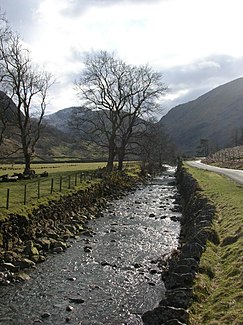Derwent (Irish Sea)
| Derwent | ||
|
The Derwent between Seathwaite and Seatoller |
||
| Data | ||
| location | Cumbria , England | |
| River system | Derwent | |
| River basin district | North West | |
| origin | The confluence of Styhead Gill and Grains Gill at Glaramara 54 ° 29 ′ 21 ″ N , 3 ° 11 ′ 2 ″ W |
|
| muzzle | at Workington in the Irish Sea Coordinates: 54 ° 38 ′ 58 ″ N , 3 ° 34 ′ 8 ″ W 54 ° 38 ′ 58 ″ N , 3 ° 34 ′ 8 ″ W.
|
|
| Flowing lakes | Derwentwater , Bassenthwaite Lake | |
| Small towns | Keswick , Workington | |
| Communities | Cockermouth , Papcastle | |
The River Derwent is a river in the Lake District in Cumbria in north-west England. The name Derwent is derived from the Celtic word for oak .
The Derwent arises above the hamlet of Seathwaite west of the Glaramara from the confluence of the Styhead Gill and Grains Gill , then flows north through the Borrowdale valley and flows into the lake Derwentwater , which it gives its name. The river leaves the lake near the village of Keswick , where the River Greta flows into it; it then flows into Bassenthwaite Lake . At Cockermouth , the River Cocker flows into the Derwent. Behind Cockermouth, the Derwent flows north past the place Papcastle , where a Roman camp was named after him. The Derwent flows into the Irish Sea at Workington .
The Bowder Stone is a large boulder near Grange in Borrowdale. His name probably comes from Balder , Odin's son from the Nordic world of gods. In 2015 the terrain near the river on the Derwent river was flooded.
